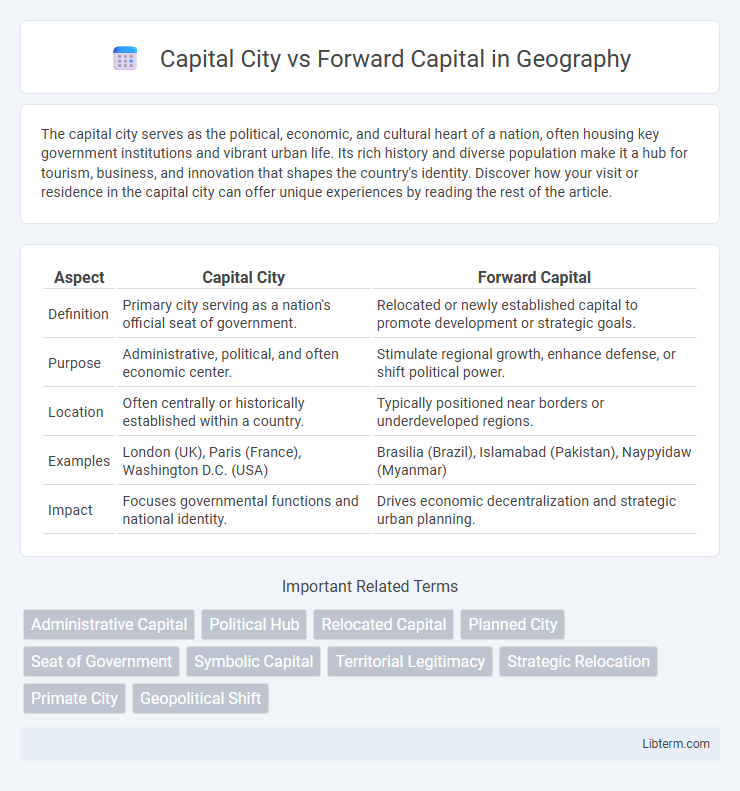The capital city serves as the political, economic, and cultural heart of a nation, often housing key government institutions and vibrant urban life. Its rich history and diverse population make it a hub for tourism, business, and innovation that shapes the country's identity. Discover how your visit or residence in the capital city can offer unique experiences by reading the rest of the article.
Table of Comparison
| Aspect | Capital City | Forward Capital |
|---|---|---|
| Definition | Primary city serving as a nation's official seat of government. | Relocated or newly established capital to promote development or strategic goals. |
| Purpose | Administrative, political, and often economic center. | Stimulate regional growth, enhance defense, or shift political power. |
| Location | Often centrally or historically established within a country. | Typically positioned near borders or underdeveloped regions. |
| Examples | London (UK), Paris (France), Washington D.C. (USA) | Brasilia (Brazil), Islamabad (Pakistan), Naypyidaw (Myanmar) |
| Impact | Focuses governmental functions and national identity. | Drives economic decentralization and strategic urban planning. |
Introduction to Capital Cities and Forward Capitals
Capital cities function as the primary administrative, political, and cultural centers of a country, where government institutions and official residences are typically located. Forward capitals, strategically established cities often in less developed or border areas, aim to promote regional development, national integration, or serve military and economic purposes. Examples of forward capitals include Brasilia in Brazil and Canberra in Australia, designed to decentralize population and administrative functions from traditional capital cities.
Defining Capital City: Meaning and Purpose
A capital city serves as the official seat of government, housing key institutions such as the executive, legislative, and judicial branches. It functions as the political, administrative, and often cultural center of a country or region. The purpose of a capital city is to centralize governance and symbolize national identity, differentiating it from a forward capital, which is relocated for strategic or defensive reasons.
Understanding Forward Capitals: Concept and History
Forward capitals are strategically relocated administrative cities established to assert governmental presence in politically sensitive or economically underdeveloped regions, serving as instruments of national integration and geopolitical assertion. Key examples include Brazil's Brasilia, designed to promote interior development, and Pakistan's Islamabad, aimed at enhancing security and administrative efficiency away from the vulnerable coastal Karachi. Historically, forward capitals have emerged as deliberate state policies to balance regional disparities, stimulate growth in peripheral areas, and symbolize a new political era distinct from traditional colonial or economic centers.
Key Differences between Capital City and Forward Capital
Capital City serves as the primary administrative and political hub, often located centrally to facilitate governance and accessibility. Forward Capital is strategically positioned near borders or conflict zones to assert control, promote development, or enhance security in contested areas. The key difference lies in their purpose: Capital Cities prioritize centralized governance, while Forward Capitals emphasize strategic, economic, or military objectives in frontier regions.
Historical Examples of Forward Capitals
Forward capitals serve as strategic instruments for asserting control over contested or peripheral regions, evident in historical examples such as Brazil's construction of Brasilia to promote inland development and India's establishment of New Delhi to symbolize power shift during colonial rule. Pakistan's creation of Islamabad functioned as a forward capital to enhance administrative efficiency and national integration away from coastal Karachi. These cases highlight how forward capitals facilitate geopolitical objectives, territorial consolidation, and economic integration within emerging nations.
Reasons for Relocating a Capital
Relocating a capital city often addresses issues such as overcrowding, vulnerability to natural disasters, or political centralization, enhancing administrative efficiency and national security. Forward capitals are strategically established in less developed or geographically advantageous areas to stimulate regional growth and improve connectivity. This move can balance economic disparities and symbolize a new national vision, promoting cohesion and sustainable urban planning.
Political and Economic Implications
Capital cities serve as central hubs for political administration and governance, concentrating governmental institutions and diplomatic activities. Forward capitals, relocated strategically to promote regional development or national integration, often stimulate economic growth by attracting investment and infrastructure projects to less developed areas. The political shift in moving a capital can reduce congestion and power concentration while fostering balanced economic opportunities and mitigating regional disparities.
Urban Planning and Infrastructure Challenges
Capital cities often face significant urban planning challenges due to high population density, historical layouts, and established infrastructure constraints, which limit large-scale redevelopment efforts. Forward capitals are strategically designed to alleviate congestion by distributing administrative functions across new, planned urban areas with modern infrastructure tailored for scalability and sustainability. These planned capitals incorporate advanced transport networks, zoning regulations, and green spaces to address issues of overcrowding, pollution, and inefficient land use common in traditional capital cities.
Case Studies: Famous Forward Capitals Worldwide
Famous forward capitals like Brasilia in Brazil, Canberra in Australia, and Islamabad in Pakistan showcase strategic relocation to promote national development and political cohesion. Brasilia was designed to stimulate inland growth and reduce coastal concentration, while Canberra was purposefully situated to balance regional interests between Sydney and Melbourne. Islamabad, planned during the 1960s, exemplifies a forward capital aimed at enhancing security and administrative efficiency away from Karachi.
Future Trends in Capital City Planning
Future trends in capital city planning highlight a shift from traditional capital cities toward forward capitals designed to address urban congestion, climate resilience, and technological integration. Forward capitals incorporate smart infrastructure, sustainable urban design, and decentralized administrative functions to foster economic growth and environmental sustainability. Governments increasingly prioritize these innovations to create adaptive, efficient, and inclusive urban hubs capable of meeting the challenges of rapid population growth and global climate change.
Capital City Infographic

 libterm.com
libterm.com